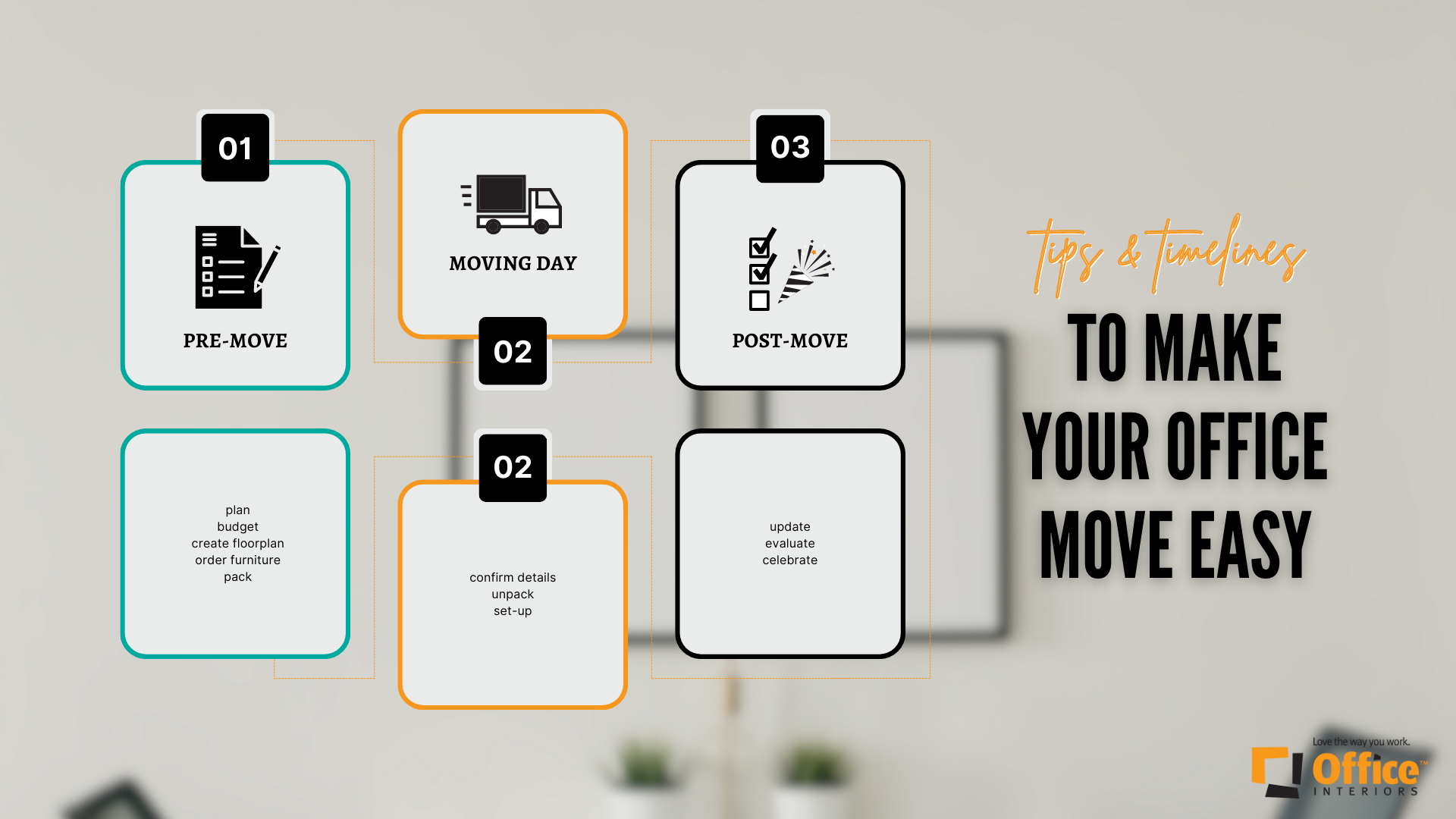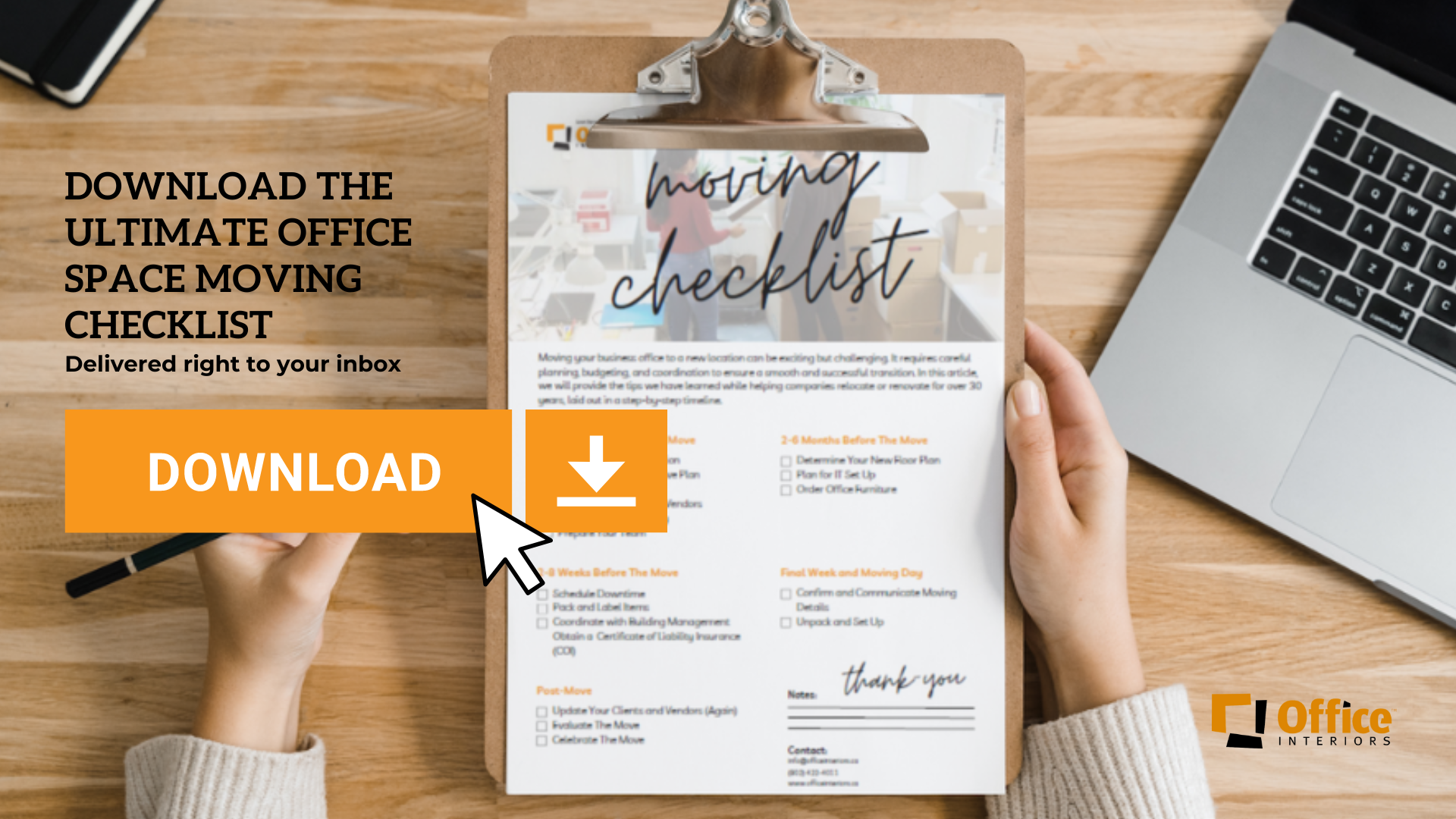The Office Move Checklist You Didn’t Know You Needed
January 7th, 2025 | 4 min read
By CJ Porteous

Moving your business office to a new location can be exciting but challenging. It requires careful planning, budgeting, and coordination to ensure a smooth and successful transition. In this article, we will provide the tips we have learned while helping companies relocate or renovate for over 30 years, laid out in a step-by-step office move checklist and timeline.
6 to 12 Months Before the Move
- Choose Your New Location: Choosing the right location for your new office is critical to the success of your business. When looking for a new location, consider factors such as location, size, accessibility, and parking. You need to ensure that the new space accommodates your immediate business needs and any plans for growth or expansion.
- Develop a Comprehensive Plan: Developing a comprehensive plan for the move is the first step in the process. Your plan should include a timeline of tasks and milestones leading up to the move. Consider budget, location, space requirements, and timeline. Start by identifying the key members of your team who will be responsible for coordinating and executing the move.
- Determine Your Budget: Determining a budget for the move is essential to ensure you have enough resources to cover all associated costs. Consider all the costs associated with the move, such as moving supplies, equipment rental, movers and any furniture or technology you might want to replace. In addition, you may want to allocate funds for contingencies such as unexpected costs or delays; complications such as poor weather, constrained parking, a busy elevator or a tradesperson rescheduling last-minute can slow a move and incur additional costs.
- Notify Your Clients and Vendors: Notifying your clients and vendors of your move is essential to maintain good relationships with them. Provide them with your new address and any other relevant information, such as changes to phone numbers or email addresses, well before your moving date.
- Hire a Moving Company: Research and hire a reputable company that fits your budget and needs. Consider factors such as experience, reputation, and insurance coverage. Start by requesting quotes from several moving companies and comparing their services and prices. Schedule a walkthrough of your current office with the moving company to get an accurate estimate of the time and resources required for the move.
- Prepare Your Team: Preparing your employees for the move is critical to ensure they are mentally, emotionally, and practically ready for the transition. Start by scheduling a meeting with your team to discuss the move and answer any questions they may have. Provide a move timeline, packing guidelines, and additional resources such as packing supplies or temporary storage.
2 to 6 Months Before the Move
- Determine Your New Floorplan: Working with a design firm or workplace planner, arrange your new floor plan to maximize your new footprint while giving your team the space they need to be productive. Examine the typical work styles of different employees to ensure that everyone receives the right mix of furniture and space to balance concentration and collaboration.
- Plan for IT Setup: It is critical to ensure your technology is set up and functioning correctly at your new location. Coordinate with your IT team or service provider to ensure a smooth transition. Identify what equipment should be relocated and what equipment should be replaced or upgraded; schedule installation and testing well before the move.
- Order Your Office Furniture: Commercial-grade products, be that office furniture or technology, often have longer lead times than consumer-grade products. From our experience, the office furniture buying process often takes seven to ten weeks, from your first conversation with an Account Manager to your furniture’s delivery and installation. Place your orders early to ensure your team is not stuck waiting on their new furniture to arrive.
2 to 8 Weeks Before the Move
- Schedule Downtime: Scheduling downtime is critical to minimize disruption to your business operations during the move. This may involve closing the office for a day or two or working with a reduced staff. Your movers will be far more efficient if the space is unobstructed. Coordinate with your staff and clients to ensure that all critical tasks are completed before the move. Consider creating a backup plan to handle any emergencies or unexpected issues that may arise during the downtime.
- Pack and Label Items: Packing and labelling items is essential to ensure that everything is accounted for and can be easily identified and unpacked at the new location. Assign packing responsibilities to your team members and provide them with packing guidelines, such as labelling requirements and handling instructions. Consider creating an inventory list of all items to be moved to ensure nothing is lost or damaged during the move and your movers can efficiently deposit everything in the correct location.
- Coordinate with Building Management: Coordinate with the building management at your current and new locations to ensure a smooth transition. This may involve scheduling elevators or loading docks for the move or obtaining necessary permits and approvals. Ensure all utilities are disconnected at the current location and connected at the new location as required.
- Obtain a Certificate of Liability Insurance (COI): If moving into a leased or rented space, the building owner or manager may require you to provide proof of COI before moving in. Then, ensure hired movers can access the space on move day by providing them with a copy of the COI. Thanks to Panda Moving of Halifax for this pro tip!
Final Week & Moving Day
- Confirm & Communicate Move Details: Confirm all the move details with your team, moving company, and building management. Ensure that all items are properly packed and labelled and that all equipment and furniture are protected during transit. Assign a team member to oversee the move and ensure everything is unloaded and deposited in the correct location in the new space.
- Unpack and Set Up: Unpacking and setting up the new office can be time-consuming. Assign responsibilities to your team members and provide them with unpacking guidelines. Consider first setting up essential equipment and furniture, such as IT equipment and desks, to ensure your team can start working as soon as possible.
Post-Move
- Update Your Clients and Vendors (Again): Updating your clients and vendors after the move is essential to ensure they have your new address and contact information. Consider sending out a formal announcement or update to all your contacts to inform them of the move and any changes to your services or operations.
- Evaluate the Move: Evaluating the move can help you identify areas for improvement and ensure a smoother transition for any future moves. Schedule a debriefing session with your team and discuss the challenges and successes of the move. Create a checklist of lessons learned and any remaining tasks that require follow-up.
- Celebrate the Move: Congrats, you did it! Celebrating the move with your employees and clients is an excellent way to boost morale and mark the beginning of a new chapter for your business. Consider organizing a company-wide event or throwing a grand opening celebration recognize the move. This can be a great way to thank your team for their hard work and dedication during the move and to build excitement for the future.
No two moves are identical, but following this office move checklist and timeline can help you prepare for the move and ensure that things go as smoothly as possible. While we don’t provide moving services ourselves, we have been a part of this journey with thousands of businesses since 1991. Don’t be shy and reach out if you want advice to design, furnish, equip and manage your new office space.
Cory Porteous
Director of Marketing
Office Interiors
Subscribe to Our Blog
Contact Us
If you’re ready to start improving productivity, streamlining processes, and love the way you work through optimized workspaces and office technology, contact us today. Our team of experts is here to help!
Topics:


